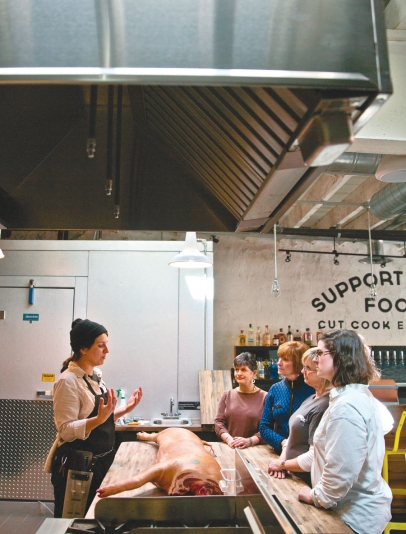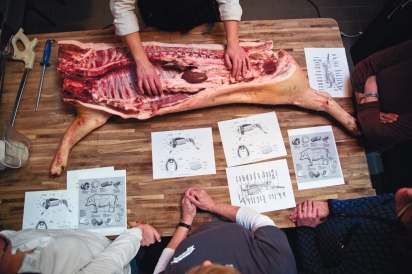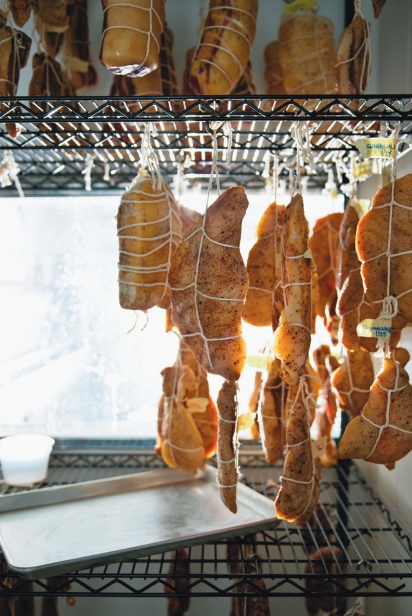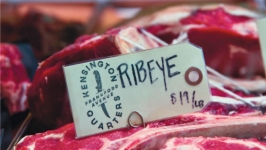Woman’s Work
At Kensington Quarters, Heather Marold Thomason busts up the butchery boy’s club
“I was a graphic designer. I sweat the details,” Heather Marold Thomason, 35, tells the group of women assembled before her in Kensington Quarters upstairs classroom space. They’re here to learn about butchery.
Thomason talks while slicing a pork belly into perfectly flat, even strips, her long knife working quickly, her movements precise. Her voice conveys an easy confidence—and just a hint of New Jersey. She wears a knit cap over her ponytail; at her waist, over a black apron, a plastic holster with knives and a honing steel hangs from a metal chain. She reaches for her knives without looking. “Muscle memory,” she tells us, “is everything. It’s all repetition. Your body knows what to do.”
It’s a sunny Sunday afternoon, and as we gather around the butcher block for Thomason’s demonstration we can hear a buzz of activity downstairs: the butcher shop closing up for the day, the restaurant preparing for dinner service, the hum of conversation from the bar. We’re here for the very first “Whole Hog Butchery for Ladies” class, which Thomason plans to teach here once a quarter.
Thomason breaks a side of pig down into primal cuts, then subprimals, explaining the finer points of hog anatomy, answering questions, and tossing off cooking tips for each cut as she works. She plops each piece down on a sheet of butcher paper and a student writes the name of each cut next to the meat in black Sharpie: Pork butt. Leaf lard. Eye round. Tenderloin.
The goals here are to demystify the cuts of meat and how butchers (and chefs) approach them, and to educate students about whole-animal butchery and humane farming. Although it’s billed as being “for ladies,” the women’s class is no different in content from the mixed-gender version: “It is not about excluding men—it’s just about including women. It’s a more supportive environment,” Thomason explains. She’s sure that half the students in this session would never have shown up for a mixed gender class. “Women don’t really think these classes are intended for them. This is an invitation.”
As for the challenges of entering the profession as a woman, Thomason is sanguine: “In any male-dominated job, you have to be as good as or better than your peers to get respect.”
During her early career at The Local Butcher Shop in Berkeley, California, she says others in her field weren’t so sure about the prospect of a female joining the ranks. “Mostly, though, it was guys trying to be gentlemen—they had good moms, so when they saw me picking up a 50-pound container of meat, they’d offer to carry it for me. And I’d say, ‘No, I’m OK,’ and carry it.”
Thomason’s career path took a few detours along the way to the butcher shop. She left her hometown of Morristown, New Jersey, after high school when she landed a coveted spot in the Alvin Ailey School of Dance at Fordham University. The ballet program was so demanding that Thomason quickly realized she would have to choose between having a dance career and having a rounded education and personal life. She switched to graphic design, but says that her dance background has served her well in butchery: “Learning the movements in breaking down a piece of meat is a lot like learning choreography,” she says, her hands tracing an arc through the air. “Your body learns the moves.”
After college she began her career in graphic design and was initially awed by her art directors. “They’d look at something and say, ‘Wouldn’t it be better if you did this?’ and I wondered if I’d ever get to that level. I didn’t know I was just around the corner—a year later I leveled up,” she laughs. Thomason and her husband founded their own design business, Bad Feather. But even as her design career moved forward, Thomason, a serious home cook since childhood, was exploring the food world and attending cooking classes. Although she had been eating a mostly vegetarian diet, she enjoyed working with meat and began to explore whole-animal butchery. “I always loved pork, though,” she says. “My initials were HAM before I got married!”
Thomason spent a week doing an intensive butchery class to see whether she wanted to consider a career in the field and to pick up fundamental skills: “I got used to deboning, holding my knife a certain way.” By the third day she asked one of the butchers, “Do you think I need to start lifting weights? Because I really want to do this.’” He told her she would build her muscles on the job—and she did. Her first apprenticeship, which took six months to find, was a physically demanding live-in job at North Mountain Pastures in Newport, Pennsylvania. “Most of working on a farm is carrying buckets of water, carrying feed, carrying fence posts from point A to point B,” she says. “About four months in I realized I could lift those heavy boxes of frozen CSA meat onto the top shelf. I got strong.”
Her experience at North Mountain made Thomason a passionate advocate of humanely raised meat. The heritage-breed pigs there are pastured on forestland, where they can root and graze as their instincts demand. Back in the butchery class, when a student asks about the difference between meat from a happy pig and meat from an unhappy one, Thomason knows just how to explain it.
“See this ruby-red color?” she asks, gesturing to the cuts before her. “Industrial meat is pale. Pasturing gives you deep red pork. And if you’ve ever noticed red flecks in your pork, that can come from stress.” The best way to tell the difference in quality, she tells the class, is by tasting the fat: “In industrial pork the fat is disgusting, but with a happy pig, the fat is actually the best part. You get a creamy, grassy flavor.” The truth of her argument is borne out the next day at dinner, when I eat the sample pork chop I’ve brought home from class. In the crisped layer of fat on its edge, there’s a distinct note of fresh grass. It’s delicious.
Her time on the farm also taught her about whole-animal butchery, the model that has guided Thomason’s career ever since. Industrial meat production, she explains, involves a great deal of waste. “When you see a huge rack of chicken legs, think how many chickens that came from. Whenever someone comes in and asks why we don’t sell chicken that way and I explain it, they always end up buying the whole chicken.” At Kensington Quarters, the butchers strive to waste as little as possible. As she breaks down the demonstration pig, Thomason sorts every scrap into tubs: one for trim—bits of meat and fat too small to sell, but useful for grinding or head cheese—and one for bones, cartilage, and other parts that aren’t edible but can impart plenty of flavor to a pot of stock in the restaurant’s kitchen. Tough strips of skin are twisted and dehydrated to make dog treats. There is no trash can here.
After her apprenticeship at North Mountain, Thomason moved to California for a position at The Local Butcher Shop, a Berkley business founded by a former Chez Panisse chef with a serious commitment to sustainable meat. She worked there for free for five months, extending her three-month internship in the hope of landing a paying job. She finally gave up—but the day before she was supposed to leave, the head butcher’s knife slipped while he was deboning a lamb leg and he stabbed himself in the abdomen, piercing his bladder. (With true butcher bravado, he finished serving the customer before quietly heading off to tend to the wound.)
Thomason stayed for a year. “I was the first girl and the first non-chef there,” she says, but she eventually earned the (sometimes grudging) respect of the shop’s top-notch butchers. There she learned to transfer her whole-animal butchery skills to the daily realities of a retail meat counter. “You’re trying to keep the cuts as big as possible,” she explains, cutting chops or steaks as customers request them in order to minimize the amount of surface area, which oxidizes when exposed to air. “If those don’t sell, you make them smaller. If that doesn’t sell, you make something from it.” It’s clear that she takes freshness seriously. “If I sell you a piece of meat, I need to give you a three- or four-day window to cook it where it’ll still be the best possible quality.”
While working at The Local Butcher Shop, Thomason began teaching classes, which was how she befriended fellow butcher Bryan Mayer. Mayer joined forces with Philadelphia restauranteurs Jennifer and Michael Pasquarello (Bufad, Café Lift, Prohibition Taproom) to open Kensington Quarters in October 2014, and called Thomason to offer her a spot on the team. It’s the city’s first whole-animal butcher shop as well as a bar and restaurant specializing in—no surprises here—charcuterie. There’s no mystery here about where the meat comes from: one table even has a window with a view of the walk-in, so customers can try head cheese while seated inches away from a hanging side of pig.
It’s a butcher’s paradise, and Thomason enjoys her job. “There’s no hierarchy here, and I get to do basically whatever I want.” She and Mayer have an ambitious series of classes planned, but Thomason says her favorite part is talking to customers. “I have people who come in here every week and ask me what they should cook. There’s one guy I’m basically teaching to cook,” she says, adding that she’s known for jotting recipes on the paper wrapping a cut of meat. “It’s quality meat, it’s not cheap, and I want to make sure everyone who buys it really gets to enjoy it.”
Another project keeps Thomason’s finger on the pulse of the nation’s food systems: she is the director of Eat Retreat (eatretreat.org), a gathering of professionals from all branches of the industry, including chefs, food producers, journalists, and advocates, all of whom apply for a limited number of spots to attend the 3-day conclave. The location changes each year, with the goal of focusing the attention of the food world on regions that stand out for their local producers and food cultures. This year’s gathering was held here in southeastern Pennsylvania, a region Thomason is eager to show the world.
Now that Fishtown has a whole-animal butcher shop, Thomason says she hopes to see more open up around the city. “Fairmount could sustain one. So could South Philly, Center City…” She envisions butcher shops as a key element in revitalizing food systems in rural areas as well.
“Some of the places where the best food is grown are near food deserts,” she points out. “If you’re not getting something great from a farmer’s market, you’re left with a few convenience stores. People would be happy to have access to good meat from good farms.” Until supermarkets took over, nearly every small town had its own butcher shop, with local meat and expert butchers who could help customers choose the right cuts and offer advice on how to cook them. Meat wasn’t cheap back then, either, she notes: “I think the trend is moving back toward eating less meat, but a better quality.”
By butchering at Kensington Quarters, she reflects, she’s come full circle from her roots. “I grew up visiting relatives out in the country in rural Pennsylvania, and I didn’t think I had anything in common with them. Then I worked on a farm in central Pennsylvania, went to California, came back, and here I am bringing that meat to urban Pennsylvania and saying, ‘I know the farm where this came from.’”
There’s more than a little of the old-school butcher in Heather Thomason, who saws bones, slices chops, and tends to customers with a practiced hand and an infectious enthusiasm. She wouldn’t have it any other way.
KENSINGTON QUARTERS
1310 Frankford Ave.
267.314.5086 kensingtonquarters.com









